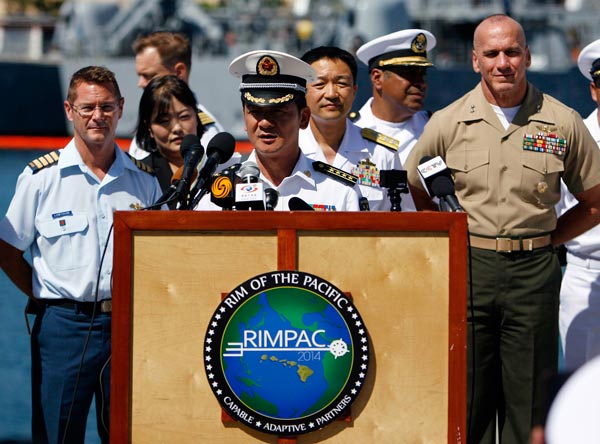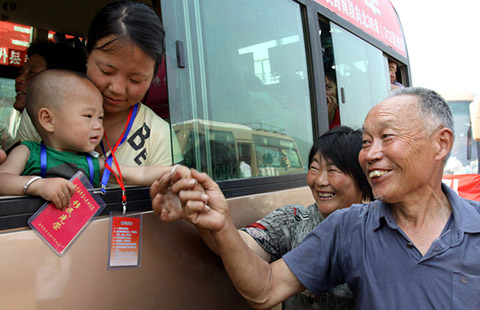China navy is RIMPAC 'highlight'
Updated: 2014-07-01 07:43
By CHEN WEIHUA in Washington and ZHANG SHAOHU in Pearl Harbor, HI(China Daily USA)
|
||||||||
|
 Zhao Xiaogang (center), drill director of the Chinese fleet participating in the RIMPAC multinational military exercise, gives a statement during a news conference kicking off the exercise at Joint Base Pearl Harbor Hickam in Honolulu, Hawaii on Monday. RIMPAC is the world's largest biennial naval exercise between the US and Pacific Rim nations and for the first time includes China. Twenty-two countries are participating. Photo/Agencies
|
In Pacific Rim exercises, hospital ships will conduct exchanges at sea
By The Chinese People's Liberation Army Navy fleet participating in the Rim of the Pacific exercise (RIMPAC) has already conducted fruitful exchanges, according to Zhao Xiaogang, drill director of the Chinese fleet.
The Chinese fleet, which includes four ships, joined multinational forces from the United States, Singapore and Brunei in Guam. They spent 10 days in a group sail from Guam to Hawaiian Islands, during which they refined their interoperability and conducted a number of exchanges involving personnel, weapon firing, ship-handling and maneuvering drills and communications exercises.
"Such activities themselves are very successful exchanges. They help promote friendship and mutual understanding," Zhao told reporters on Monday.
Zhao said attending many receptions hosted by navies of participating nations are also great mutual exchanges. The Chinese navy also hosted a deck reception on June 28, which drew officers from the participating nations as well as senior officers from the US Pacific Fleet.
"I think it (RIMPAC) is a platform of great significance and with good outcome," Zhao said. He revealed that the exchanges conducted by PLA Navy also included the Japanese and Philippine navies. The two US allies have maritime territorial disputes with China.
Zhao said it was natural for the Chinese fleet, which is participating in RIMPAC for the first time, to be put under the command of US side.
He said the PLA Navy's participation in RIMPAC is primarily aimed at promoting a steady and healthy development of the new type of relationship between the Chinese and US militaries.
It is also aimed at joining the navies from participating nations to strengthen exchanges and deepen cooperation and to demonstrate the positive attitude of the Chinese army in maintaining world peace and promoting regional security and stability, Zhao said.
He made the remarks at the opening day of the RIMPAC on Monday, when Vice Admiral Kenneth Floyd, commander of the US Third Fleet, highlighted China's participation.
Floyd, who serves as commander of the 2014 RIMPAC Combined Task Force, noted on Monday that China and Brunei are participating in the RIMPAC for the first time. Meanwhile, for the first time in RIMPAC's history, two hospital ships are taking part.
He was referring to the US Navy hospital ship USS Mercy and the Chinese People's Liberation Army Navy hospital ship Peace Ark, which Floyd visited on June 28 in Pearl Harbor. The two hospital ships will conduct exchange programs during RIMPAC.
The four Chinese ships participating include missile destroyer Haikou, missile frigate Yueyang, supply ship Qiandaohu and hospital ship Peace Ark, with a total of 1,100 personnel, making it the second-largest representation following only the host nation, the US.
"The training at RIMPAC is realistic and relevant. The relationships that are forged at RIMPAC span oceans and years," Floyd said in a statement posted Monday on the US Navy website.
"Ask any veteran of RIMPACs past, and they will tell you that what stands out most in their memory is the chance to work alongside sailors of different navies and ships of different nations, improving their skills and building trust so that when we are called upon to respond to a crisis or disaster, we are ready to respond as a team," Floyd's statement read.
Harry Harris, commander of the US Pacific Fleet, said as the world's largest international maritime exercise, RIMPAC provides a unique training opportunity that helps armed forces increase transparency and foster the cooperative relationships that are critical to ensuring security on the world's oceans.
This is the 24th installment of RIMPAC, which started in 1971 and has been held biennially ever since. This year it has drawn 25,000 sailors, marines, airmen and soldiers from 22 nations, 55 ships and submarines and more than 200 aircraft. The largest military drill in history ends on Aug 1.
"Everyone standing here with me today recognizes how valuable a cooperative approach can be to sharing the workload and leveraging unique national capabilities," Harris said at the RIMPAC opening press conference in Pearl Harbor on Monday.
"We can all appreciate that conflict and crisis are bad for business. I think it's important to note that by simply attending RIMPAC, every nation here is making the bold statement that we must improve multinational military cooperation despite disagreements," he said.
"We can agree to disagree without being disagreeable," he said.
Douglas Paal, vice-president for studies at the Carnegie Endowment for International Peace in Washington, said he was glad that China was sending ships to RIMPAC while other activities in the relationship were taking place.
Paal was clearly referring to the indictment by US Justice Department of five PLA officers for cyber theft of US corporate secrets, a move he interpreted as "non-strategic". China used to suspend its military exchanges with the US upon major incidents, such as US arms sales to Taiwan.
"If we can keep those two engaged, and they don't break off, and get angry with each other, that will help," Paal said of the two militaries.
He believes this is especially important when commanders have each other's cell phone numbers and can call in the middle of a sudden crisis, such as ships bumping into each other or similar incidents.
The growing number of close encounters between the PLA Navy and US Navy on the seas has caused concern about possible accidents due to misunderstandings or miscalculation.
Colleen Hanabusa, a US Congresswoman from Hawaii, said there is no question that China is a major player in the Asia Pacific Rim.
"I think China participating in the RIMPAC and the role that China continues to play (in the region) is important," Hanabusa said.
"We are not going into military action. China is not going into military action. So we are in a better position that we all realize that the world is large enough for the great powers. And great powers must lead by example," she said.
In Beijing on July 9-10, China and the US will embark on the sixth meeting of the China-US Strategic and Economic Dialogue (S&ED).
US Secretary of State John Kerry and Treasury Secretary Jack Lew, as US President Barack Obama's special representatives, will go to Beijing for the S&ED. They will be joined by their respective Chinese co-chairs, State Councilor Yang Jiechi and Vice-Premier Wang Yang, along with high-level delegations from both sides.
The dialogue will focus on addressing the challenges and opportunities that both countries face on a wide range of bilateral, regional and global areas of immediate and long-term economic and strategic interest, according to a statement by the US Department of State.
In Beijing, Kerry will also participate in the fifth annual China-US Consultation on People-to-People Exchange on July 9-10 in coordination with Chinese Vice-Premier Liu Yandong.
In a meeting with US Ambassador to China Max Baucus in Beijing on Monday, Chinese Foreign Minister Wang Yi said building a new type of major country relationship conforms to the fundamental and long-term interest of the two nations.
"It is also the expectation of the international community," Wang said.
chenweihua@chinadailyusa.com
- Xinjiang publishes anti-terror brochures
- Security pact sealed with Afghanistan
- President Xi encourages international cultural exchanges
- Premier Li: China willing to help Afghan infrastructure
- Chinese FM: China, Asia-Pacific become community of shared destiny
- Foreign minister remarks on possibility of China-Japan summit
Most Viewed
Editor's Picks

|

|

|

|

|

|
Today's Top News
VW defends safety of recalled New Sagitar
Former premier makes Hurun philanthropists list
Xinjiang publishes anti-terror brochures
SOHO endows $10m to Yale
Cook and Ma talk about partnership
Language a barrier to healthcare for Asian Americans
China businesses need innovation: VC
Security pact sealed with Afghanistan
US Weekly

|

|
















